A) A
B) B
C) C
D) D
E) E
G) B) and D)
Correct Answer

verified
Correct Answer
verified
Multiple Choice
Which of the letters shown on this figure would most likely have mafic (basalt) magmas? 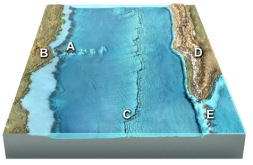
A) A and B
B) A and C
C) B and D
D) D and E
E) C and D
G) A) and C)
Correct Answer

verified
Correct Answer
verified
Multiple Choice
Which of the magma systems shown is most likely to include felsic or intermediate magmas? 
A) A and B
B) B and C
C) A,B,and C
D) B,C,and D
E) C,D,and E
G) C) and E)
Correct Answer

verified
E
Correct Answer
verified
Multiple Choice
What does this texture indicate about the formation of this rock? 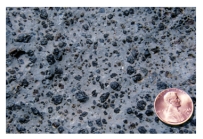
A) It formed from an explosive pyroclastic eruption.
B) The rock solidified at great depth.
C) The magma formed some crystals before rising closer to the surface and solidifying.
D) The magma had abundant dissolved gas.
F) B) and C)
Correct Answer

verified
Correct Answer
verified
Multiple Choice
Which of the following changes in conditions indicates heating of the rock? 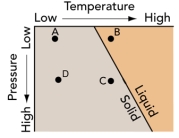
A) from A to B
B) from B to C
C) from C to D
D) from D to A
E) none of these
G) All of the above
Correct Answer

verified
Correct Answer
verified
Multiple Choice
Which of the letters shown on this figure would most likely have magma related to subduction? 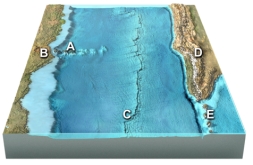
A) A and B
B) A and C
C) B and D
D) D and E
E) C and E
G) B) and D)
Correct Answer

verified
Correct Answer
verified
Multiple Choice
The igneous feature shown in this figure is a: 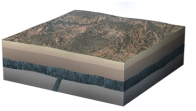
A) dike
B) sill
C) volcanic neck
D) laccolith
F) A) and C)
Correct Answer

verified
Correct Answer
verified
Multiple Choice
What texture is displayed by the igneous rock in this photograph? 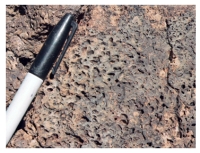
A) vesicles
B) breccia
C) porphyritic
D) glassy
E) none of these
G) B) and D)
Correct Answer

verified
Correct Answer
verified
Multiple Choice
Which of the letters shown on this figure would most likely have magmas related to a hot spot? 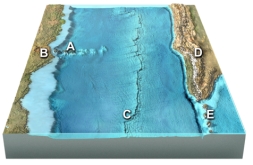
A) A
B) B
C) A and B
D) C
E) D and E
G) D) and E)
Correct Answer

verified
Correct Answer
verified
Multiple Choice
What texture is displayed by the igneous rock in this photograph? 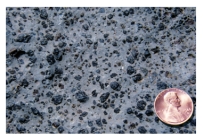
A) vesicles
B) breccia
C) porphyritic
D) glassy
E) none of these
G) B) and D)
Correct Answer

verified
Correct Answer
verified
Multiple Choice
Which of the following is NOT a way that magma can lose heat to begin solidifying?
A) conduction to surrounding solid rocks
B) loss of thermal energy to the air and water
C) water that is heated and circulated near the magma
D) an increase in the rate of radioactive decay
F) A) and C)
Correct Answer

verified
Correct Answer
verified
Multiple Choice
Which of the following is the best example of heat transfer by conduction?
A) newly created lithosphere loses heat to adjacent rocks
B) water flows in a circular path in a pan
C) a burner gives heat through the air without touching the object
D) seawater is drawn into a mid-ocean ridge
F) A) and B)
Correct Answer

verified
Correct Answer
verified
Multiple Choice
The igneous rocks shown in this photograph are forming: 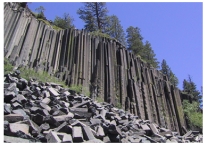
A) a dike
B) an irregular pluton
C) a volcanic neck
D) columnar joints
F) B) and D)
Correct Answer

verified
Correct Answer
verified
Multiple Choice
Which are important ways that magma can raise through the crust?
A) through fractures that can form dikes
B) pieces of the wall rocks that break off and provide space
C) tectonic forces can help open pathways
D) magma is hotter and less dense than its surrounding
E) all of these
G) None of the above
Correct Answer

verified
Correct Answer
verified
Multiple Choice
Which of the following was NOT involved in forming magmas of the main batholith?
A) subduction beneath western North America
B) water that caused partial melting of hot mantle
C) partial melting of continental crust
D) solidification of magma below the surface
E) recent normal faulting along the east side of the batholith
G) A) and B)
Correct Answer

verified
Correct Answer
verified
Multiple Choice
The main process that happens during the alpha type of radioactive decay is:
A) an electron is given off
B) an electron is absorbed and turned into a neutron
C) an atom splits into two pieces
D) an alpha particle combines with a small atom to make a larger one
F) A) and D)
Correct Answer

verified
C
Correct Answer
verified
Multiple Choice
Which of the following factors helps magma rise toward Earth's surface?
A) pressure decreases with increasing depth
B) magma is more dense and therefore tougher than the surrounding solid rocks
C) gas bubbles generally form at great depth and drive magma upward
D) none of these
F) A) and C)
Correct Answer

verified
Correct Answer
verified
Multiple Choice
A hot spot is interpreted to have formed from:
A) extreme heating of the seas near the equator
B) abundant magma produced within a subduction zone
C) abundant magma formed within a typical mid-ocean ridge
D) a rising plume of hot mantle material
F) None of the above
Correct Answer

verified
D
Correct Answer
verified
Multiple Choice
A volcanic breccia texture indicates that:
A) there was a lot of gas in the magma
B) the rock cooled quickly
C) the rock broke apart as it flowed
D) the rock cooled slowly
E) the ash and pumice were hot and became compacted
G) B) and D)
Correct Answer

verified
Correct Answer
verified
Multiple Choice
The main way water gets into a subduction zone is by:
A) heating of the overlying continental crust
B) a decrease in pressure that causes melting
C) rain associated with eruptions in the island arc
D) seawater introduced into oceanic crust at the mid-ocean ridge,prior to subduction
E) all of these
G) A) and E)
Correct Answer

verified
Correct Answer
verified
Showing 1 - 20 of 103
Related Exams